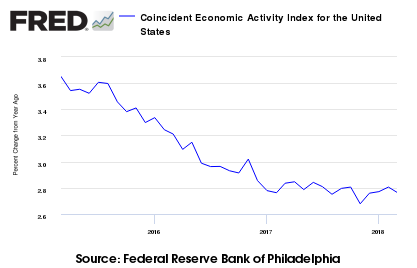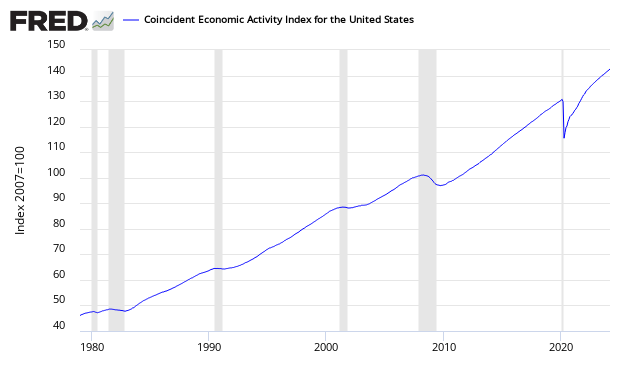
A comparison of US Coincident Index, Aruoba-Diebold-Scotti business conditions index, Conference Board’s Coincident Index, ECRI’s USCI (U.S. Coincident Index), and Chicago Fed National Activity Index (CFNAI) coincident indicators follows.
Economic indicators that coincide with economic movements are coincident indicators. Coincident indicators by definition do not provide a forward economic view. However, trends are valid until they are no longer valid, making the trend lines on the coincident indicators a forward forecasting tool. Â Econintersect‘s analysis of the coincident indices is that:
- There is general agreement that the economy is expanding – but disagree whether the rate of growth is increasing or decreasing.
- You cannot take most of these coincident indices to the bank – as they are subject to backward revision.
- The economy is expanding at main street level – but the growth is so slow it is not noticeable.
Excerpt from Philly Fed Report for the United States Coincident Index
The Federal Reserve Bank of Philadelphia has released the coincident indexes for the 50 states for January 2014. In the past month, the indexes increased in 48 states and remained stable in two, for a one-month diffusion index of 96. Over the past three months, the indexes increased in 50 states, for a three-month diffusion index of 100. For comparison purposes, the Philadelphia Fed has also developed a similar coincident index for the entire United States. The Philadelphia Fed’s U.S. index rose 0.2 percent in January and 0.7 percent over the past three months.
[click graph below to enlarge]
This index is up 0.2% month-over-month, 0.7% up quarter-over-quarter, and up 3.1% year-over-year – all degraded from last month.
/images/z philly coincident.PNG
The Philly Fed produces this real time coincident indictor report based on six underlying indicators:
- Weekly initial jobless claims
- Monthly payroll employment
- Industrial production
- Personal income less transfer payments
- Manufacturing and trade sales
- Quarterly real GDP



